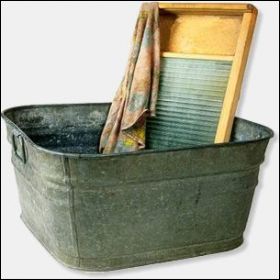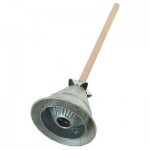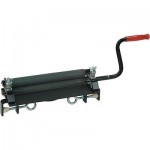 We’ve decided that our next prepper goal is to be able to hand wash laundry. Washing machines require lots of power and lots of water, if you’re without either of those doing laundry gets much harder. Though we now do laundry every week, in a collapse it will not be as high of a priority or done with that frequency. But cleaning clothes and linens will still be important because they will last longer, keep us healthier, and overall improve moral and make life feel more “normal”.
We’ve decided that our next prepper goal is to be able to hand wash laundry. Washing machines require lots of power and lots of water, if you’re without either of those doing laundry gets much harder. Though we now do laundry every week, in a collapse it will not be as high of a priority or done with that frequency. But cleaning clothes and linens will still be important because they will last longer, keep us healthier, and overall improve moral and make life feel more “normal”.
We’ve never hand washed laundry before, so I began doing research on the process and what equipment we would need. There were several variations of the basic idea:
- Use a washboard to scrub off stains. Apparently, contrary to popular opinion, washboards are smooth and won’t damage the fabric. They’re said to be a relatively easy way to remove stains.
- Fill a tub full: This could be anything from a bathtub, a kitchen sink, a 5-gallon bucket, or an old fashion washing tub. Fill with cold, warm, or hot water as needed.
- Add soap: From my reading I’ll probably just use a small amount of dish detergent. If you use laundry detergent use a very small amount; if it’s powder detergent dissolve it first in water before adding. Historically a bar of soap was grated into the water. You need to find the balance of enough soap to clean the clothes while avoiding too much soap that will be difficult to rinse out. Let clothes soak for at least 30 minutes before washing.
 Agitate the clothes in the water: It looks like the easiest thing to use would be a clean (preferably new) toilet plunger. We found a ‘Tin-Plated Steel Washer’ in the Lehman’s catalog which looks like a metal plunger. Lehman’s states, “Just plunge up and down to force soap and water through clothes and linens — it’s that simple.”
Agitate the clothes in the water: It looks like the easiest thing to use would be a clean (preferably new) toilet plunger. We found a ‘Tin-Plated Steel Washer’ in the Lehman’s catalog which looks like a metal plunger. Lehman’s states, “Just plunge up and down to force soap and water through clothes and linens — it’s that simple.”- Rinse the clothes, probably more than once. Soap left in the clothes will break down the fibers.
- Wring the water out of the clothes: This can be done by hand, or much more efficiently with a hand wringer. Again in Lehman’s they
 state their hand wringers “. . . remove up to twice as much water as a spin dry.”
state their hand wringers “. . . remove up to twice as much water as a spin dry.” - Hang the clothes to dry: This can be done either outdoors on a traditional clothes line, if weather and temperatures permit, or inside on drying racks. (Remember to get clothes pins for outdoor drying.)
So that’s the process. Our plan is to buy:
- A washboard (Lehman’s $16 – $23)
- Two galvanized wash tubs (about $40 – $50 each), they’re a good size and easily portable, plus they also have many other uses.
- A Tin-Plated Steel Washer (Lehman’s $18.95).
- A hand wringer (wide range of prices and quality).
- A large indoor drying rack. Living here in the Pacific Northwest we’ll probably have to dry inside most of the time.
Once we get everything we’ll give it a few test runs and, of course, I’ll post about how those go.
